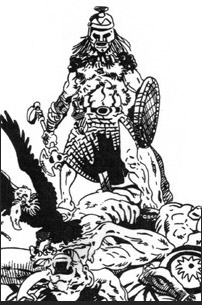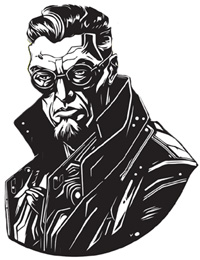Writing character-based fiction as opposed to the standard plot-driven method seems to be the province of the author of speculative fiction. This method trends to narrow the scope of the narrative, and is intended to immerse the reader in the storyline ‘alongside’ the character by limiting the reader’s perspective to that of the character.
Since most readers come to your work habituated to reading from ‘behind’ the protagonist, with the invisible narrator acting as a tour guide, they can become impatient with not knowing more about the fictional world than the protagonist. Readers want to have one up on the character, and get a little peek around from a better vantage, even when they are thrilled to be alongside him in the story.
How do you accommodate this reader dichotomy?
George R. R. Martin convinced me that the way to do it was to provide a large character rotation, with key characters taking their turn as the protagonist. Gene Wolfe has successfully written some of the best speculative viewpoint fiction of our era with only a single protagonist. While this takes the ultimate level of craftsmanship and results in heavily immersed readers, it does not appeal as widely as Martin’s method simply because only so many people will want to identify exclusively with that one character.
Another advantage to Martin’s method is that it leaves open the threat of death for the protagonist. When Latro, the Protagonist in Wolfe’s Soldier of Arete, is telling his story, the reader obviously knows he survived. It is Wolfe’s genius to still infuse the reader with fear for Latro despite this.
The greatest pitfall of Martin’s method is the need to craft a realistic perspective from multiple points of view, and to be able to constantly generate replacements for those protagonists who leave the story. You don’t want to slip up and have your crack-dealer speaking like your math-teacher while your gun-nut forgets who he hates. Where Wolfe is taking a depth risk, Martin is taking a breadth risk. As a learning writer who has adopted these two established authors as my models I have split the difference. Permit me to outline my method below.
The Alien Perspective
I have chosen to write primarily from the perspective of alienated characters. I do this for multiple reasons: this is how I have lived my life; I believe many readers live in a conditional state of alienation as most of those surrounding them do not read; it permits a realistic level of critical observation concerning exotic cultures; and there is a built in struggle between the protagonist and society. I do not expect school teachers, politicians or the Joint Chiefs of Staff to have any interest in my work.
Perspective Models
Religion: I have spent decades immersing myself in the study of religions without permitting myself to become a believer. I have done this largely in order to be able to craft fiction from a religious perspective, which I suppose marks me for numerous punishments in various after lives.
Lonely Sites: My main character in The Sunset Saga is Three-Rivers, a visitor to the 21st Century from pre-colonial America; when the Eastern Woodlands covered 98% of the land and there was not a piece of metal, a slab of concrete, or a stretch of asphalt to be seen, and before the concept of a fence was known. Was there a place I could go to put me in the frame of mind he would be in, as a ‘Natural Person’ transplanted to modern America?
To look at something that was just completely urban would do nothing to assist me with this meditation, a creature as I am of that environment. I needed something that looked lonely and was not pristine wilderness, but ‘used’ land. I needed something in between; something desolate, something with trees; something that was transitory, as Three-Rivers never had any intention of staying in the 21st Century [which he thinks of as Nearest Sunset], but of journeying beyond to Furthest Sunset.
Something lonely...
Something barren…
Something torn up…
Something preserving vestiges of the natural world…
Something seemingly circumscribed by man, bounded by his ambition...
Something temporary…
I found my model at a subsidized apartment complex that had been leveled, all but the few old trees and the sunken stairwells and basements. The site had also been fenced. To Three-Rivers the idea of a fence, particularly a barrier made of a substance that did not exist in nature, but was the product of the ‘Whiteman’s medicine’, was the most disconcerting of concepts, the metaphor for the extermination of his people and the conquest of their world by an alien force.
The site is scheduled to be developed, so, knowing that it would not always be there for me to stroll around and wonder before beginning another Three-Rivers story, I had my sister photograph it, in winter, at sunset, on a rainy day. The pictures that she enhanced with the sketch effect feature on her camera served as the ‘cover’ art for Of The Sunset World, Pillagers of Time, The World is Our Widow, Behind the Sunset Veil, and Den of The Ender. After that site is developed I’ll have to find another place to get in touch with Three-Rivers, being as he is an undomesticated strand of my imagination, who doesn’t always come when I call.
The Pace of Change: We live in a rapidly changing world. Instead of clinging to the past, or embracing the latest change blindly while turning your back on the past, use these two impulses. If you are a writer take that yearning for the days before smart phones to remember the old, rather than resist the new. The times we live in provide us with much food for speculation.
Your Past: If you can honestly recall how you thought and felt at a certain age in your youth, qualify that in your notes. When I was a teenager I was essentially a stupid psychopath. I evolved out of that, but chose never to forget less I fall back into those behaviors. At some times in my life I have devolved under stress, and have had to put myself back on the trail of personal improvement. But, having been a nut-job, I write a good one.
Children: I always step aside and observe children at family gatherings, without trying to impose my presence. Observe how they see the world, a new world for them, in which they are only beginning to find their way. I have used this for the basis of some of my time-travel characters brought out of the past.
The Elderly: We have real time-travelers among us, people who were born before most of the gadgets that occupy our work and leisure were even imagined. Find that regressive elder in your life and ask them what they think of things. Just get them going. We have a whole generation of folks that feel like they are suddenly on an alien planet. Tap into their perspective.
The Serial
I write event-based chapters in my novels that are little different from the free serials I post online. By placing a firm time-limit or situational constraint on the protagonist I necessarily limit their perspective and keep the reader bottled up with them—hopefully. Do not permit any chapter, even the last, to give all of the answers. Do not let your reader close the book knowing all. You must keep them wondering. In particular, readers of speculative fiction tend to read experientially just to feel that sense of wonder. Wolfe, and before him Howard, were the masters of this, of invoking an otherworldly atmosphere. This was largely accomplished by Howard due to the constrained length of his publishing niche. It is not the key by a long shot, but a valuable ingredient.
The Novelette
So far, I have only been able to maintain a single perspective up to novelette length. Hurt Stoker, my ongoing serialized novel, is my first attempt at a full length work of fiction from a single unified perspective. Without limiting, boxing myself in with an outline, or counting words, my novelettes all seem to fall into a tight length, at around 13,500 words.
The Novelette-length Interlude
In some cases I have written chapters in the middle of a novel that have run to novelette length to provide a conceptual demarcation, an interlude, like directors once used in epic-length movies. I really wonder if I could get this practice by an editor. If I was not using a titled ‘dramatic persona’ table of contents I think it would be wrong. Plopping a novelette in the middle of a novel, is, in my mind, justified in the context of writing a long series of novels.
By the time I was writing Den of The Ender, I was acutely conscious from reader feedback, that Randy Sterling Bracken, conflicted Hindu White Supremacist gun-nut, had become a favorite. Although he was not planned as a cast member for that novel, I knew some readers would be wondering what he was doing while his brother was waging a chronological war. After all, his primary characteristic is an inability to stay out of trouble.
Not only would readers miss him, it was patently out of character for him to lay low and do nothing but prepare for his next time jump. The operational protocol for the chronological replication service he works for called for Randy to spend a year researching, training, and gearing up for a trip back to 212 B.C to retrieve Archimedes right before an anonymous Roman kills him while he is factoring his famously unknown equation. Randy Bracken could only have one possible response to that directive, “Fuck that!”
So I wrote Vagina Be Gone! [Women are one of Randy’s major points of self-contention.] a story within a story. Aside from the rational given above for doing this on the basis of the character likely rejecting the author’s judiciously conceived plot, the other rational brings us back to the title of this article. Randy is the most alienated character in The Sunset Saga. For various back-story reasons explained in the nightmare sequences that plague his restless alcohol-induced attempts at sleep, Randy stands farther apart from the world he was born into than the ancients and primitives that he and the other time-jumpers have reclaimed from the past. Disconnecting his story from the novel, yet including it as a parallel interlude, serves the cause of maintaining his lonely plight, which is central to his character. I use this same technique with shorter-length pieces as an epilogue to some novels in the series.
If you too are a writer of speculative fiction I hope at least one of the methods above might be something as yet unused that could be applied to your efforts.
If you are a reader, I hope that the realization that speculative fiction is not just daydreaming and story-telling enhances your reading experience. Works of speculative fiction are model-based investigations into what makes us who we are, and how and why we keep on going, knowing as we do that an unfinished ending awaits us all.











